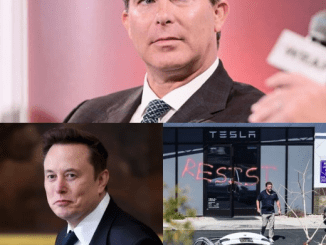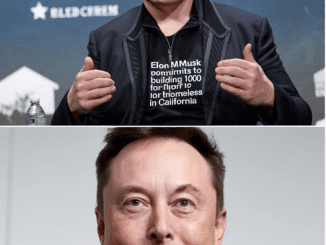
Elon Musk has always been a man of audacious dreams, from colonizing Mars to creating sustainable energy solutions, but one of his most ambitious goals is close to being realized: a world dominated by autonomous vehicles, with Tesla leading the way. Musk’s ultimate vision is not just about electric cars—it’s about creating a revolutionary new ecosystem in which fully autonomous Teslas operate as robotaxis, providing a passive income for their owners and disrupting the traditional transportation model forever.
While Tesla’s electric vehicles (EVs) are already revolutionizing the auto industry, Musk’s vision for the future is far more disruptive. His goal isn’t just to sell cars; it’s to redefine how people use, own, and think about transportation. Autonomous driving is at the core of this revolution, and with every software update, Tesla moves a step closer to making robotaxis a reality.
The Journey to Full Autonomy
Tesla’s Full Self-Driving (FSD) system has been one of the most anticipated and controversial developments in the automotive world. While Level 5 autonomy (complete self-driving without human intervention) has yet to be achieved, Tesla’s FSD software continues to progress, with each update bringing improvements in navigation, decision-making, and safety. Musk’s mantra has always been that “data is the key to success”, and Tesla’s advantage lies in its ability to collect real-world data from its vast global fleet of vehicles.
Unlike other competitors who rely primarily on simulation models to train their autonomous systems, Tesla has a unique edge in real-world driving. Every time a Tesla car hits the road, it’s collecting valuable data that feeds into the FSD system, allowing it to improve at an exponential rate. According to Tesla, millions of miles of real-world driving data are being used to continuously improve the software, which gives it a significant advantage over competitors stuck in simulation-only development models.
This massive data pool allows Tesla’s AI to learn faster, safer, and more efficiently than anyone else in the autonomous driving race. By utilizing high-resolution cameras, ultrasonic sensors, and radar, Tesla vehicles are able to perceive the world around them in incredible detail. Combined with the power of Tesla’s Dojo supercomputer, which processes the data at unprecedented speeds, the Tesla FSD system becomes more intelligent with every update.
Tesla’s Vision: A Fleet of Robotaxis
The idea of a robotaxi might sound like science fiction, but Musk believes it is the future of urban mobility. Imagine this: You buy a Tesla car, and when you’re not using it, it drives itself around as a taxi, picking up passengers and earning money for you. This concept, known as “Tesla Network”, is poised to disrupt car ownership as we know it.
In Musk’s vision, you won’t need to own a car in the traditional sense. Instead, your Tesla will be a self-sustaining asset that can generate passive income by being part of the Tesla ride-sharing network. Tesla owners will be able to send their cars out on the road to pick up passengers, run errands, and drive themselves back to you, all while generating income. In essence, your Tesla would be a vehicle that works for you, even when you’re not in it.
Why Tesla Has the Edge
Tesla’s position as a leader in autonomous driving stems from a combination of advanced AI technology, real-world data collection, and proprietary hardware. Other companies like Waymo and Cruise have made significant strides in autonomous driving, but they have yet to match Tesla’s global fleet and real-world data collection capabilities.
Tesla’s approach is also more integrated, as its vehicles are not just autonomous but are also part of a broader energy ecosystem. Autonomous Tesla vehicles can seamlessly integrate into the Tesla Network, while also benefiting from Tesla’s solar energy solutions, making the entire system more sustainable and self-sufficient.
The Dojo supercomputer plays a crucial role in processing the vast amounts of data generated by Tesla’s fleet. This AI-driven system enables Tesla to handle complex tasks, such as object detection, predictive modeling, and real-time decision-making, to ensure that FSD vehicles can safely navigate diverse environments.
What’s Next for Tesla’s Autonomous Future?
While the dream of robotaxis is still a few years away, Tesla continues to make significant strides. In recent years, Tesla has rolled out its FSD Beta program, allowing a select number of owners to test the system in real-world conditions. The feedback from these drivers is helping Tesla refine the software, while also providing valuable insights into how the system performs in everyday driving scenarios.
As Tesla continues to iterate on its autonomous software and make advancements in AI technology, it’s only a matter of time before robotaxis become a staple of urban transportation. And when that happens, the impact on the transportation industry will be monumental.
What Does This Mean for the Future of Transportation?
Elon Musk’s vision for a world full of autonomous Teslas isn’t just about technology; it’s about changing the way we live. The advent of robotaxis will likely lead to fewer cars on the road, less congestion, and lower emissions, making cities more sustainable and efficient. But it could also reshape the way we think about mobility, making it more accessible, affordable, and convenient for everyone.
If Tesla’s robotaxis become a widespread reality, they will likely serve as a new standard of transportation. Musk’s ultimate goal is to create a fully autonomous world, one where personal vehicles are no longer necessary for many people and where autonomous ride-hailing services become the default mode of transport.
The Road Ahead
Tesla’s pursuit of autonomous driving is undoubtedly one of the boldest technological ambitions in modern history. But with Musk’s relentless drive and Tesla’s relentless pursuit of innovation, it’s becoming increasingly clear that the future of transportation will be autonomous.
As Tesla continues to make breakthroughs in AI, real-world data collection, and autonomy, Musk’s vision of a global fleet of robotaxis might be closer than ever. Will Tesla’s robotaxis redefine the way we live, work, and travel? Only time will tell—but one thing is certain: Tesla is on the road to change the world.
What are your thoughts on Tesla’s robotaxi future? Will this revolutionize transportation, or is it just another ambitious dream from Musk? Let us know in the comments!


